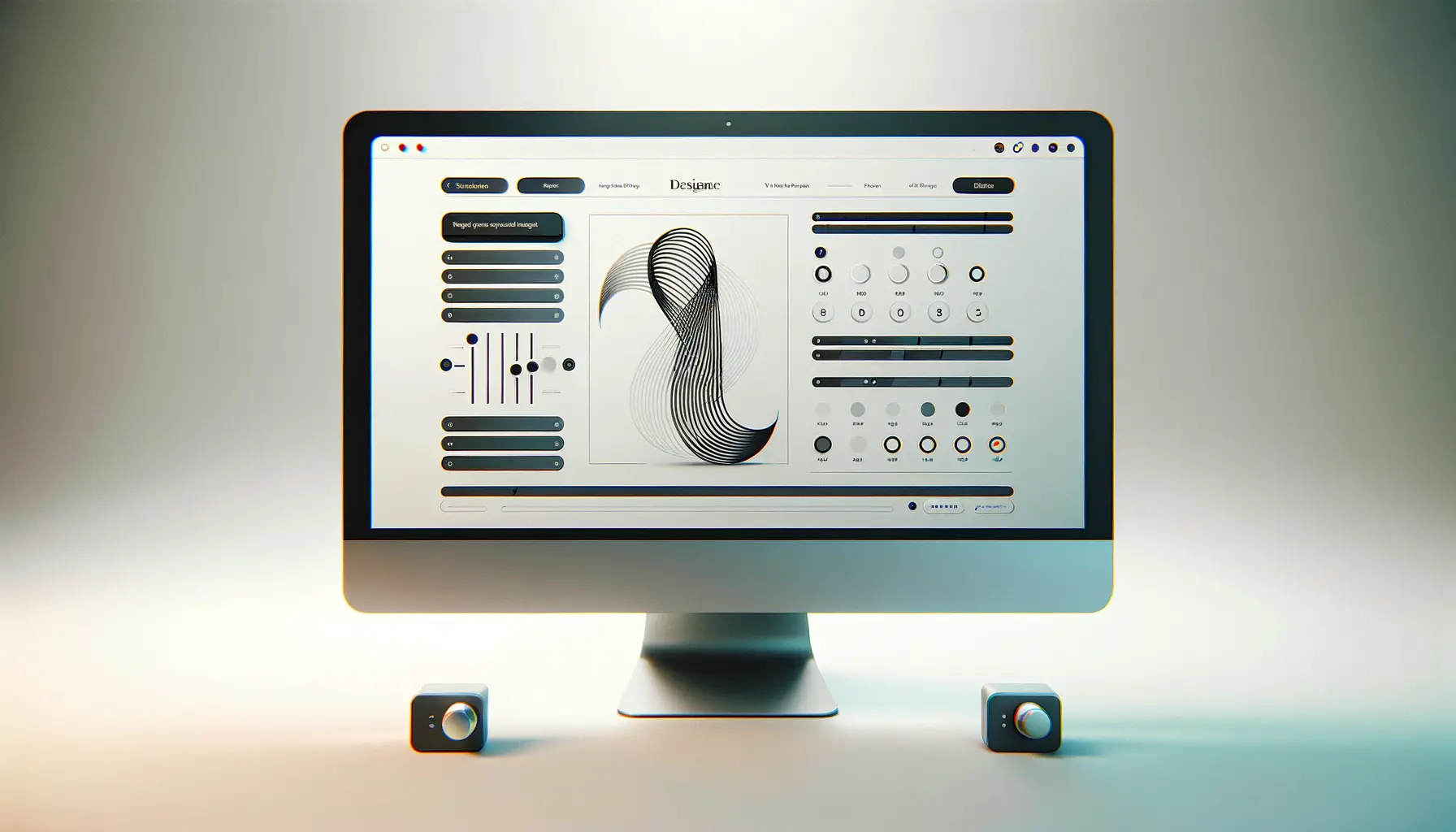The allure of handwritten fonts in the realm of typography is undeniable.
These fonts, with their unique curves and strokes, bring a personal touch to digital spaces, standing out amidst the uniformity of typed text.
The charm of handwritten fonts lies in their ability to mimic the nuances of human handwriting, making digital communication feel more intimate and engaging.
This personal touch is crucial in a world where digital content is omnipresent, as it helps messages resonate more deeply with audiences.
Handwritten fonts are not just about aesthetics; they are a strategic choice for brands and designers aiming to convey authenticity, creativity, and emotional resonance.
In an era where consumers are bombarded with digital content, the distinctiveness of handwritten fonts can cut through the noise, capturing the audience’s attention and leaving a lasting impression.
This article explores the multifaceted reasons behind the effectiveness of handwritten fonts in engaging audiences and enhancing communication.
- The Psychological Impact of Handwritten Fonts
- Enhancing Brand Identity with Handwritten Fonts
- Handwritten Fonts in Digital and Print Media
- Impact of Handwritten Fonts on User Engagement
- Optimizing Handwritten Fonts for Readability
- Integrating Handwritten Fonts into Web Design
- Future Trends in Handwritten Font Usage
- Embracing the Timeless Charm of Handwritten Fonts
- FAQs on Why Handwritten Fonts Capture Audience Attention
The Psychological Impact of Handwritten Fonts
Handwritten fonts hold a unique place in the psychology of perception.
They are perceived as more personal and intimate compared to their typed counterparts.
This perception stems from the inherent uniqueness of human handwriting, where no two letters are exactly alike, unlike the uniformity of typed text.
The psychological impact of this uniqueness is significant; it can make the reader feel a direct connection to the writer, as if the message was crafted specifically for them.
This psychological connection is further reinforced by the nostalgia associated with handwritten notes.
In a digital age, a handwritten note is a rarity, a relic of a time when personal communication was the norm.
By tapping into this nostalgia, handwritten fonts can evoke emotions and memories, making digital content feel more personal and impactful.
This emotional engagement is a powerful tool for brands looking to establish a strong connection with their audience.
Authenticity and Trust
In the context of branding and marketing, authenticity is a key factor in building trust with audiences.
Handwritten fonts contribute to this sense of authenticity by adding a human touch to digital communications.
This human element can make brands appear more approachable and genuine, qualities that are highly valued by consumers.
In a marketplace where consumers are increasingly skeptical of marketing messages, the authenticity conveyed by handwritten fonts can be a significant advantage.
Moreover, the use of handwritten fonts signals a departure from the impersonal and often sterile nature of digital communication.
It suggests that a brand values personal connection and is willing to go the extra mile to communicate in a more human-centric manner.
This can foster a sense of trust and loyalty among consumers, as they feel valued and understood on a personal level.
Incorporating handwritten fonts into your digital communication strategy can transform the way your audience perceives your brand, making it appear more authentic, trustworthy, and connected to its human roots.
Enhancing Brand Identity with Handwritten Fonts
Handwritten fonts play a pivotal role in shaping and enhancing a brand’s identity.
They offer a unique blend of personality and style that can set a brand apart in a crowded marketplace.
By carefully selecting a handwritten font that aligns with the brand’s values and aesthetic, companies can create a memorable brand identity that resonates with their target audience.
The choice of a handwritten font can convey a wide range of attributes, from elegance and sophistication to fun and approachability.
This versatility makes handwritten fonts an invaluable tool in the arsenal of brand designers seeking to communicate specific brand traits and values.
Key Attributes Conveyed by Handwritten Fonts
- Personality: Handwritten fonts are imbued with character, which can infuse a brand with a distinct personality. This personality can help in creating a brand voice that is relatable and engaging.
- Approachability: The informal nature of handwritten fonts can make a brand appear more approachable and friendly. This is particularly effective for brands aiming to establish a close relationship with their audience.
- Elegance: Certain handwritten fonts exude elegance and sophistication, making them ideal for luxury brands that wish to convey a sense of exclusivity and high quality.
- Creativity: Handwritten fonts are often associated with creativity and innovation. Brands in the creative industries can leverage these fonts to highlight their creative ethos.
Strategies for Incorporating Handwritten Fonts into Branding
Successfully incorporating handwritten fonts into a brand’s visual identity requires strategic thinking.
The font should complement the brand’s overall design language and communicate the intended message effectively.
Here are some strategies to consider:
- Use handwritten fonts for logo design to create a memorable and distinctive brand mark.
- Incorporate handwritten fonts in key branding materials, such as business cards and packaging, to maintain consistency across all touchpoints.
- Select a handwritten font that aligns with the brand’s target audience and market positioning. For instance, a playful handwritten font may appeal to a younger demographic, while a more refined script could attract a luxury-focused audience.
- Balance handwritten fonts with more traditional typefaces to ensure readability and professionalism in longer texts.
Choosing the right handwritten font is crucial in crafting a brand identity that is authentic, memorable, and aligned with the brand’s values and audience expectations.
Handwritten Fonts in Digital and Print Media
The application of handwritten fonts extends across both digital and print media, each offering unique opportunities and challenges for designers.
In the digital realm, handwritten fonts can add a personal touch to websites, emails, and social media content, making digital interactions feel more human.
In print, handwritten fonts are often used in advertising, packaging, and editorial design to draw attention and convey specific emotional tones.
Understanding the nuances of using handwritten fonts in these different media is key to maximizing their impact and ensuring that the message is communicated effectively and appropriately.
Digital Media Applications
- Websites: Handwritten fonts can be used for headings, call-to-action buttons, or special announcements to grab attention and add personality to web design.
- Email Campaigns: Incorporating handwritten fonts in email headers or signatures can make marketing communications feel more personal and less automated.
- Social Media: Posts and ads featuring handwritten fonts can stand out in crowded social media feeds, engaging users with their unique appearance.
Print Media Applications
- Advertising: Handwritten fonts in print ads can draw the reader’s eye and convey a sense of authenticity, especially in industries where personal touch is valued.
- Packaging: Product packaging utilizing handwritten fonts can convey a handcrafted or artisanal quality, appealing to consumers seeking authenticity.
- Editorial Design: Magazines and books may use handwritten fonts for article titles or pull quotes to add emphasis and visual interest.
Challenges and Considerations
While handwritten fonts offer numerous benefits, their use also presents certain challenges.
Legibility is a primary concern, especially in digital media where screen sizes and resolutions vary.
Designers must ensure that the chosen font is readable across all potential viewing scenarios.
Additionally, the tone conveyed by the font must be appropriate for the brand and context.
A mismatch between the font style and the message or audience can lead to confusion or dilute the brand’s identity.
Another consideration is the potential overuse of handwritten fonts, which can make content appear cluttered or unprofessional.
Balancing handwritten elements with more neutral typefaces can help maintain a clean and organized design.
Effective use of handwritten fonts requires a careful balance between creativity and functionality, ensuring that the design remains accessible and aligned with the brand’s messaging.
Impact of Handwritten Fonts on User Engagement
Handwritten fonts have a profound impact on user engagement, influencing how audiences interact with content across various platforms.
By adding a personal touch to digital and print media, these fonts can significantly increase the time users spend with content, enhance memory retention, and encourage positive emotional responses.
Understanding the psychological and emotional effects of handwritten fonts is crucial for designers and marketers aiming to create compelling and engaging content.
Enhancing Memory Retention
Research suggests that the unique characteristics of handwritten fonts can enhance memory retention among readers.
The slight irregularities and imperfections in handwritten text require the brain to engage more deeply with the content, leading to better recall of information.
This effect can be particularly beneficial for educational materials, marketing messages, and any content where retention is a key objective.
Moreover, the distinctiveness of handwritten fonts helps in differentiating content in a crowded marketplace.
When consumers are exposed to vast amounts of information daily, content presented in a unique font is more likely to be remembered and associated with the brand.
Driving Emotional Connections
Handwritten fonts can evoke a range of emotions, from warmth and comfort to excitement and creativity, depending on the style of the font.
This emotional resonance is a powerful tool for building a connection with the audience.
By carefully selecting a handwritten font that aligns with the desired emotional response, brands can create content that resonates on a deeper level with their target audience.
Emotional connections forged through thoughtful design can lead to increased brand loyalty and advocacy.
Consumers are more likely to engage with and support brands that they feel an emotional bond with, highlighting the importance of font choice in branding and marketing strategies.
Influencing User Behavior
The psychological impact of handwritten fonts extends to influencing user behavior.
Fonts that evoke trust and authenticity can encourage users to take action, such as making a purchase or signing up for a newsletter.
Similarly, fonts that convey urgency or excitement can drive users to engage with time-sensitive content or promotions.
Designers can leverage the attributes of handwritten fonts to guide user behavior in a desired direction.
For example, a call-to-action button in a handwritten font may appear more inviting, prompting higher click-through rates compared to a standard typed font.
The strategic use of handwritten fonts can significantly enhance user engagement, making content not only more memorable and emotionally resonant but also more effective in driving desired user actions.
Optimizing Handwritten Fonts for Readability
While handwritten fonts offer unique advantages in terms of engagement and emotional impact, optimizing these fonts for readability is crucial to ensure that the message is effectively communicated.
Poorly chosen or improperly used handwritten fonts can lead to confusion, strain, and a negative user experience.
This section outlines strategies for maximizing the readability of handwritten fonts across various media.
Choosing the Right Font
- Legibility: Select fonts that are easy to read at various sizes. Avoid overly decorative or intricate fonts for body text.
- Context Appropriateness: Ensure the font style matches the tone and context of the content. A casual handwritten font might not be suitable for formal documents.
- Compatibility: Check the font’s compatibility across different platforms and devices to ensure consistent display.
Font Size and Spacing
- Size Adjustments: Use larger font sizes for headings and subheadings to create a clear hierarchy and improve scanability.
- Line Spacing: Increase line spacing (leading) to enhance readability, especially for longer passages of text.
- Letter Spacing: Adjust letter spacing (tracking) to prevent letters from merging, particularly in all-caps settings.
Color and Contrast
- High Contrast: Ensure high contrast between the font color and the background to make the text stand out and easy to read.
- Color Choices: Use colors that complement the overall design but do not sacrifice readability for aesthetic reasons.
Combining Fonts
Pairing handwritten fonts with more traditional typefaces can balance personality with readability.
Use handwritten fonts for elements that require emphasis, such as titles or quotes, and pair them with sans-serif or serif fonts for body text.
This approach maintains the unique character of the handwritten font while ensuring that the content remains accessible and legible.
Testing and Feedback
Conduct user testing to gather feedback on the readability of the chosen handwritten font.
Observing how real users interact with the content can provide valuable insights into potential readability issues.
Adjust font choices, sizes, and spacing based on user feedback to optimize the reading experience.
Effective optimization of handwritten fonts for readability involves careful selection, appropriate sizing and spacing, and the strategic use of color and contrast. Combining fonts and conducting user testing are also key steps in ensuring that the content is both engaging and accessible.
Integrating Handwritten Fonts into Web Design
Integrating handwritten fonts into web design requires a thoughtful approach to maintain the balance between uniqueness and usability.
As websites serve as a primary point of interaction between brands and their audiences, the choice of font plays a crucial role in defining the user’s experience.
This section explores practical tips for effectively incorporating handwritten fonts into web design, ensuring that the site remains user-friendly while showcasing the brand’s personality.
Strategic Placement
- Headlines and Titles: Use handwritten fonts for headlines, titles, or featured sections to draw attention and add character.
- Call-to-Action Buttons: Applying handwritten fonts to call-to-action buttons can make them stand out and encourage clicks.
- Accent Text: Incorporate handwritten fonts sparingly as accent text for quotes, testimonials, or special announcements to add emphasis without overwhelming the design.
Performance Considerations
- Font Loading: Optimize font loading times by using web-friendly font formats and limiting the number of font variations loaded.
- Responsive Design: Ensure that the handwritten font scales appropriately across different screen sizes and resolutions for a consistent user experience.
User Experience (UX) Design
- Readability on All Devices: Test the font’s readability on various devices, including smartphones and tablets, to ensure that text remains legible.
- Navigation Clarity: Maintain clear and easy-to-use navigation by using handwritten fonts judiciously, ensuring that usability is not compromised.
Combining with Visual Elements
Handwritten fonts can be effectively combined with other visual elements such as images, icons, and textures to create a cohesive and engaging design.
Pairing fonts with complementary visual styles can enhance the overall aesthetic of the website and reinforce the brand’s identity.
However, it’s important to maintain a balance to avoid visual clutter and ensure that the content remains the focal point.
Accessibility
Accessibility should be a key consideration when integrating handwritten fonts into web design.
Ensure that the website remains accessible to users with disabilities by providing alternative text descriptions for important handwritten text elements and offering the option to switch to more readable fonts if needed.
Adhering to web accessibility guidelines ensures that the website is inclusive and usable for all visitors.
Assuming that all handwritten fonts will be equally effective across all types of web design is a common misconception. The success of a handwritten font in web design depends on its strategic placement, performance optimization, and integration with the overall design and user experience strategy.
Future Trends in Handwritten Font Usage
The use of handwritten fonts has evolved significantly over the years, and this trend is expected to continue as technology advances and consumer preferences shift.
The future of handwritten font usage in both digital and print media is likely to be shaped by innovations in font design technology, increased focus on personalization, and the ongoing search for authenticity in brand communications.
This section explores potential future trends in the use of handwritten fonts.
Technological Advancements in Font Design
As font design software becomes more sophisticated, designers will have greater flexibility in creating and customizing handwritten fonts.
This could lead to the development of fonts that more closely mimic natural handwriting, including variations in pressure, angle, and flow.
Additionally, advancements in web technologies may make it easier to implement complex handwritten fonts without compromising website performance or user experience.
Increased Personalization
Brands are continually seeking ways to personalize their communications and connect with audiences on a more individual level.
Handwritten fonts offer a unique opportunity for personalization, as they can be tailored to reflect specific brand personalities or even to mimic the handwriting of individuals within the organization.
As consumer demand for personalized experiences grows, we may see an increase in the use of bespoke handwritten fonts across various brand touchpoints.
Authenticity and Emotional Engagement
In an increasingly digital world, consumers crave authentic experiences and emotional connections with brands.
Handwritten fonts, with their inherent warmth and personality, are perfectly suited to meet this need.
Future trends may include a greater emphasis on selecting and designing handwritten fonts that convey genuine emotion and authenticity, helping brands to forge deeper connections with their audience.
Integration with Augmented Reality (AR) and Virtual Reality (VR)
As AR and VR technologies become more prevalent, the use of handwritten fonts in these immersive environments could offer exciting new ways to engage users.
Handwritten fonts could be used to add a personal touch to virtual spaces, making digital experiences feel more human and relatable.
This application of handwritten fonts could extend to educational content, virtual branding experiences, and interactive storytelling.
Sustainability and Handwritten Fonts
The growing focus on sustainability and eco-friendly practices may influence the use of handwritten fonts, particularly in print media.
Fonts that require less ink for printing without sacrificing legibility or aesthetic appeal could become more popular.
This would align with broader industry trends towards reducing environmental impact while maintaining high standards of design and communication.
The future of handwritten font usage is bright, with potential advancements in technology, personalization, and immersive digital experiences driving innovation. As brands and designers continue to explore the possibilities of handwritten fonts, we can expect to see them used in increasingly creative and impactful ways.
Embracing the Timeless Charm of Handwritten Fonts
The exploration of handwritten fonts reveals their undeniable impact on capturing audience attention in both digital and print media.
As we’ve navigated through the intricacies of their psychological impact, brand identity enhancement, and integration into web design, it’s clear that handwritten fonts offer a unique blend of personality, authenticity, and emotional engagement that is hard to replicate with standard typefaces.
The future trends in handwritten font usage promise even greater personalization and technological advancements, ensuring that this timeless design element remains at the forefront of creative communication.
The Enduring Appeal of Handwritten Fonts
Handwritten fonts hold a special place in the hearts of audiences and designers alike, offering a touch of humanity in a digitalized world.
Their ability to convey authenticity and foster emotional connections makes them a powerful tool in the arsenal of any brand looking to stand out and resonate with its audience.
As we look to the future, the continued evolution of handwritten fonts in design and technology is poised to offer even more innovative ways to engage and captivate users.
Strategic Integration for Maximum Impact
For brands and designers, the strategic integration of handwritten fonts into various media requires a thoughtful approach.
Balancing legibility with aesthetic appeal, ensuring compatibility across platforms, and aligning font choices with brand identity are crucial steps in leveraging the full potential of handwritten fonts.
The thoughtful application of these fonts can transform ordinary content into engaging, memorable experiences that leave a lasting impression on the audience.
- Legibility and readability must always be a priority, ensuring that the beauty of handwritten fonts does not compromise the clarity of the message.
- Choosing the right handwritten font that aligns with the brand’s personality and audience expectations can significantly enhance brand identity and user engagement.
- Future advancements in technology and personalization will likely open new avenues for the creative use of handwritten fonts, offering exciting possibilities for brands to connect with their audiences in meaningful ways.
Conclusion
In conclusion, the captivating allure of handwritten fonts in engaging audiences cannot be overstated.
Their unique ability to add a personal touch, convey authenticity, and evoke emotional responses makes them an invaluable asset in the world of design.
As we move forward, the integration of handwritten fonts will continue to be a key element in creating compelling and memorable brand experiences.
Whether through digital platforms, print media, or emerging technologies, handwritten fonts will undoubtedly remain a timeless tool for capturing the hearts and minds of audiences worldwide.
Quality web design is key for a great website! Check out our service page to partner with an expert web design agency.
FAQs on Why Handwritten Fonts Capture Audience Attention
Explore common questions about the unique appeal of handwritten fonts.
Handwritten fonts mimic personal handwriting, adding a unique, authentic touch that stands out in digital and print media, making content feel more personal and engaging.
They infuse personality and authenticity into a brand’s visual communication, helping to establish a memorable and relatable brand identity that resonates with audiences.
Yes, by evoking emotions and creating a personal connection, handwritten fonts can significantly enhance user engagement and content memorability.
While versatile, they’re best used for headlines, call-to-actions, and branding elements where their unique charm can be most effective without compromising readability.
Legibility and overuse are key challenges, requiring careful selection and strategic use to ensure content remains accessible and visually appealing.
They can enhance readability by drawing attention, but must be used judiciously, especially in longer texts, to avoid straining the reader’s eyes.
Advancements in technology and a growing demand for personalization are likely to lead to more customized and authentic handwritten font applications.
Consider the font’s personality, legibility, and how well it aligns with the project’s tone and objectives to ensure it enhances the overall design effectively.











